 Image search results - "japantemple" Image search results - "japantemple" |

Established in 1617, Tsukiji Hongwanji temple is the Tokyo headquarters of the Nishi Hongwanji Jodo Shinshu sect. The present temple, based on Indian architecture, was built in the 1930s.The temple is the only one in Japan which is under the direct control of the sect. Its head priest is the Monshu Abbot himself. April 8 is observed as Buddha's birthday, called Hana Matsuri ("Flower Festival) in Japan.
|
|

Tsukiji Hongwanji temple gate with wisteria crest.The emblem is a wisteria flower and symbol of the Jodo Shinshu sect.
|
|

Kitain Main hall, Kawagoe
|
|
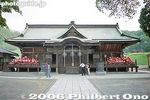
Shorinzan Daruma Temple 少林山達磨寺Daruma offerings on both sides of the temple.
|
|

Pagoda at Kitain temple, Kawagoe
|
|
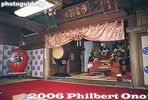
Inside the Daruma temple, Takasaki.
|
|

Meaning "Long Life Temple," Chojuji's Hondo temple hall is a National Treasure. It belongs to the Tendai Buddhist Sect and one of the Konan Sanzan Temple Trio along with Jorakuji and Zensuiji Temples.Chojuji temple Entrance gate + fall colors.
|
|

Psst, wanna know a secret? Kitain Temple, Kawagoe
|
|

Right balcony of Daruma temple, Takasaki
|
|

Takahata Fudoson Kongoji temple, Hino, Tokyo 高幡不動尊金剛寺
|
|

Horyuji temple, Nandaimon Gate, National Treasure 南大門(国宝)
|
|

Fudo Hall on left and Horinkaku on the right, Takahata Fudoson Kongoji temple, Hino, Tokyo
|
|

Dai-Hondo Hall, Nishi-Arai Daishi, Tokyo 大本堂According to legend, when prayers were offered to save villagers from an epidemic, pure water gushed out of a hitherto dried-up well and got rid of the plague. Since the well was on the west side of the temple hall, this area came to be called "Nishi-Arai" (New Well in the West). The temple is famous for warding off fire and misfortune.
|
|

Hosenji temple in Nakano-ku, Tokyo. Belongs to the Shingon-shu Sect, Buzan School. 宝仙寺
|
|

Horyuji temple Five-Story Pagoda and Kondo Hall, National Treasures 五重塔 金堂
|
|

Tahoto Pagoda at Gokokuji temple in Bunkyo, Tokyo. Built in 1938 modeled after the original Tahoto Pagoda at Ishiyama-dera temple in Otsu, Shiga Prefecture. 多宝塔
|
|

Hanamatsuri service inside the Tsukiji Hongwanji temple
|
|

Horyuji Goju-no-To (Five-Story Pagoda) National Treasure. Houses a few bones of Shakyamuni Buddha. 五重塔
|
|

Horyuji temple Kondo Main Hall, the world's oldest wooden building at 1,300 years old. National Treasure 金堂
|
|

Horyuji temple, Daikōdō Hall, National Treasure 大講堂
|
|

Chojuji temple Hondo temple hall, National Treasure in Konan, Shiga.The hondo once burned down, but was rebuilt during the Kamakura Period.
|
|

Horyuji temple, Yumedono Pavilion, National Treasure. The Nippon Budokan martial arts hall in Tokyo was designed after this pavilion. 夢殿
|
|
|

Benten-do
|
|

Pagoda and Hondo temple hall
|
|

Benten-do
|
|
|

Jorakuji's Three-story pagoda is also a National Treasure Built in 1400.
|
|
|
|

Kannon stone buddha
|
|

Rengeji Hondo Hall, Banba-juku, Maibara, Shiga. Quite a few emperors favored this temple. The 95th Emperor Hanazono (1297-1348) gave the temple an Imperial sanction to receive Imperial prayers. Hence, the temple's Imperial crest. 蓮華寺
|
|

Inside Rengeji Hondo Hall, main altar at the center. There are two figures: Amida Nyorai and Shaka Nyorai. Jodo-shu Buddhist sect. 蓮華寺 本堂
|
|
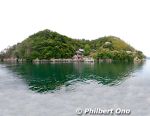
Chikubushima on Lake Biwa is home to Hogonji Temple first built in 724 as ordered by the Emperor to worship the Goddess Benzaiten. It belongs to the Shingon Buddhist Sect (Buzan School) and it is the 30th temple in the 33-Temple Pilgrimage of Saigoku.
|
|

Karamon Gate 唐門 (National Treasure) before it was restored in March 2020. See the next photo.
|
|
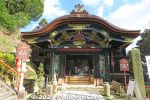
Karamon Gate 唐門 (National Treasure) beautifully restored to its original splendor. Entrance to the Kannondo Temple.This gate is said to have come from Toyotomi Hideyoshi's Gokuraku Bridge at Osaka Castle in the early 17th century (Momoyama Period). Chikubushima, Nagahama, Shiga.
|
|
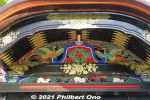
Some of the wood carvings had pieces that broke off or worn out. So they were reconstructed too. The metal fittings were also re-plated or remade.
|
|
|
|

Benzaiten-do Hall, the main worship hall of Hogonji temple.
|
|

Inside Benzai Tendo.
|
|

Exterior of Great Buddha, Kamakura
|
|

Entrance Gate. This is where you pay admission. 総門
|
|

San-mon Gate. Built in 1802. 三門
|
|

Eigenji Hondo temple hall. Built in 1765. Higashi-Omi, Shiga
|
|

Eigenji Hondo temple hall. Built in 1765. Higashi-Omi, Shiga
|
|

Inside Hondo temple hall, Eigenji
|
|

In Nov. 2016, Eigenji temple in Higashi-Omi showed its hidden Kannon for the 1st time in 30 years. Serene, golden face.
|
|
|

Eigenji Temple
|
|

Gotokuji temple's Hondo Main Hall, Setagaya, Tokyo. Ii clan's family temple. 本堂
|
|

Shelf for beckoning cats, maneki neko at Gotokuji temple in Setagaya, Tokyo.
|
|

Beckoning cats, maneki neko, which did their duty for their owners who now offer them to the temple as a gesture of thanks. Gotokuji temple, Tokyo.
|
|

Only Ii Naosuke's grave has a sign explaining about him.
|
|

Grave of Lord Ii Naosuke (1815-1860), the lord of Hikone Castle in Shiga Prefecture and Chief Minister of the Tokugawa Shogun's government. Gotokuji temple, Setagaya-ku, Tokyo. 井伊直弼の墓 豪徳寺
|
|

Konpon Chudo Hall is a National Treasure and Enryakuji's main worship hall and largest building. It enshrines Yakushi Nyorai, the buddha of healing and health. 根本中堂
|
|
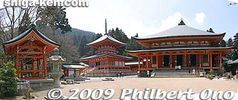
Hokke Soji-in Toto pagoda on the left and the Amida-do Hall on the right. Enryakuji temple, Mt. Hiei, Otsu, Shiga.
|
|

Shaka-do Hall, Enryakuji
|
|

Yokawa Chudo Hall in Enryakuji, Mt Hiei, Otsu, Shiga.
|
|
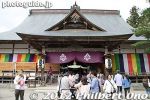
Chusonji's Hondo main hall in Hiraizumi. It was last rebuilt in 1909. Its main object of worship is Amida Nyorai (the Buddha of Infinite Light), flanked by Chūsonji's eternal flames which came from Enryakuji in Shiga Prefecture.
|
|
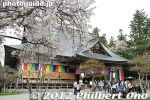
Chusonji's Hondo main hall, Hiraizumi, Iwate Prefecture.
|
|
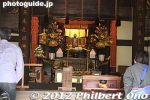
Altar inside Chusonji's Hondo main hall.
|
|
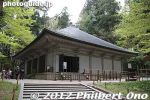
The Golden Hall is indeed gold and beautiful. It's not that big and looks brand new, thanks to restoration work. The gold leaf gleams and shell inlays in the columns are intricate.
|
|
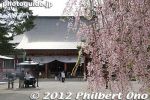
Weeping cherries and Motsuji's Hondo hall in Hiraizumi, Iwate Prefecture.
|
|
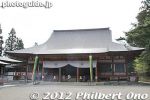
Motsuji's Hondo main hall was built in 1989.
|
|

Inside Motsuji's Hondo main hall. It worships Yakushi, flanked by two Boddhisatvas, Nikko ("Daylight") and Gakko ("Moonlight").
|
|

Hyakusaiji's Main temple hall (hondo). Important Cultural Property.
|
|

Inside hondo, Hyakusaiji
|
|
|

Soshido Main Hall, Ikegami Honmonji. The original Main Hall was burned during an bombing raid in April 1945. 大堂(祖師堂)
|
|
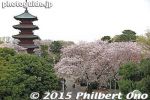
Ikegami Honmonji, Tokyo
|
|

Hoto means "Treasure Tower." A beautiful building. Ikegami Honmonji, Tokyo 宝塔
|
|

Takeshima in Hikone, Shiga. Map
|
|

Nichiren Monument on Takeshima. This giant stone monument is inscribed with the prayer words "Namu Myo-horenge-kyo" from the Lotus Sutra. 南無妙法蓮華経
|
|

Nichiren temple
|
|

View of Takeshima, an island with many shapes.
|
|
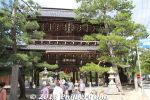
Visitors to Amanohashidate can hardly miss Chionji Temple when you see this large Sanmon gate next to the entrance of Amanohashidate at the southern end. Since you're there, might as well see the temple too. 山門Map: https://goo.gl/maps/Anjk19rRLzT2
|
|
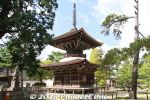
The elegant Tahoto Pagoda, a National Important Cultural Property. 多宝塔
|
|
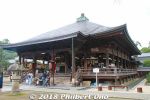
Chionji's main temple hall, Monjudo. 文殊堂
|
|

Kawasaki Daishi Temple, Dai-hondo main worship hall 大本堂
|
|

Inside Dai-hondo main hall at Kawasaki Daishi. Kobo Daishi (Kukai 774-835), the founder of the Shingon Buddhism is enshrined. The Goma kito fire prayer is held here a few times every morning and afternoon. 大本堂
|
|

Hanamatsuri, pouring sweet tea over the baby Buddha.
|
|

Octagonal 5-story pagoda 八角五重塔 (中興塔)
|
|

Kinkakuji Gold Pavilion 金閣寺
|
|

Kinkakuji Gold Pavilion, Kyoto
|
|
|

Kinomoto Jizo-in Hondo temple hall on the left and giant Jizo statue on the right. 木之本地蔵院
|
|

Giant Jizo statue and incense burner, Kinomoto Jizo-in, Shiga 木之本地蔵院
|
|

Altar in Amida-do hall, Jizo-in, Kinomoto, Shiga 阿弥陀堂
|
|

Kiyomizu-dera Gate
|
|

Kiyomizu-dera temple on wooden stilts. Kiyomizu-dera belongs to its own independent Buddhist sect.
|
|

Kiyomizu-dera is the 16th temple in the Saigoku Western Japan pilgrimage circuit. The Hondo main hall dates from 1633.
|
|

Kiyotaki Tokugen-in temple's three-story pagoda
|
|
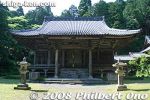
Kannonji temple Hondo main hall in Maibara, Shiga. Ishida Mitsunari was suppsedly a young monk here where he met Toyotomi Hideyoshi.
|
|
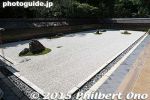
Ryoanji temple in Kyoto has Japan's most famous rock garden.
|
|
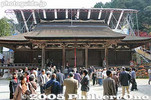
Japan's first National Treasure undergoing renovation of the roof. Saimyoji temple's Hondo hall (National Treasure) in Kora, Shiga. 本堂In 1571, Oda Nobunaga ordered Saimyoji to be burned down right after scorching Enryakuji on Mt. Hiei. Fortunately, this Kamakura-Period main hall and the pagoda survived.
|
|

Saimyoji temple Hondo Hall (National Treasure) in Kora, Shiga. In 1571, Oda Nobunaga ordered Saimyoji to be burned down right after torching Enryakuji on Mt. Hiei. Fortunately, this Kamakura-Period main hall and the pagoda survived. 本堂
|
|

Oda Nobunaga burned Saimyoji right after scorching Enryakuji on Mt. Hiei. Fortunately, the main hall and the pagoda survived. 3-story pagoda, a National Treasure
|
|

3-story pagoda and fall colors. Photography is not allowed inside, but I highly recommend going inside. Admission 1,000 yen.
|
|

Finally we see a building
|
|

On Aug. 9, the Jizo statues are lit with candles.
|
|

Kongorinji's Temple Hondo, a National Treasure in Aisho, Shiga.
|
|

Temple Hondo, a National Treasure
|
|

3-story pagoda, reconstructed in 1978
|
|

Kongorinji's Main temple roof drowning in fall leaves
|
|

Temple bell
|
|

On Aug. 9, the Jizo statues are lit with candles.
|
|
|
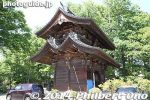
Menuma Shodenzan's Kisomon Gate has three gables called "sanhafu." Very unusual. Kumagaya, Saitama
|
|
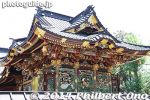
Menuma Shodenzan temple
|
|
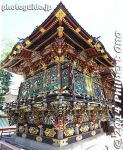
Menuma Shodenzan Kangiin temple, a National Treasure in Kumagaya, Saitama. 歓喜院聖天堂 奥殿の彫刻
|
|
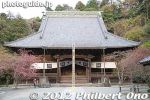
Soshido Hall at Myohonji temple, Kamakura. Temple's main hall. 祖師堂
|
|

Kannon-do complex at Miidera temple, Shiga.
|
|

Manpukuji's Kaizan-do Hall (Important Cultural Property) where sect founder Yinyuan Longqi (Ingen) is worshipped. 開山堂(かいさんどう)
|
|

Chinese design on the railing. Temple buildings are in Ming-style. Many buildings are Important Cultural Properties, but no National Treasures. 卍崩しのデザイン
|
|

Daiohoden Hall (Important Cultural Property), Manpukuji's main worship hall or temple. 大雄寶殿(だうおうほうでん)
|
|

Chinese wooden fish drum for beating during prayers.
|
|

Manpukuji's famous fish board. 魚梆
|
|

Goeido Founder's Hall. For several years, the Nishi Hongwanji buildings were hidden by construction scaffolding as they underwent major renovations. Finally, we get to see all the buildings unobstructed. 御影堂
|
|

Goeido Founder's Hall at Nishi Hongwanji, Kyoto. The building is an Important Cultural Property. 御影堂
|
|

Goeido Founder's Hall
|
|

Hiunkaku Pavilion is a National Treasure. Unfortunately, it is not open for public viewing. One of Kyoto's Three Best Pavilions along with Kinkakuji and Ginkakuji Pavilions. 飛雲閣
|
|

Bell tower at Nishi Hongwanji
|
|

Amida-do Hall is an Important Cultural Property at Nishi Hongwanji, Kyoto. 阿弥陀堂(本堂)
|
|

Inside the Goeido Hall. You have to take off your shoes to enter. This was on Jan. 1, 2010. 御影堂
|
|

A short walk from the temple halls is this ornate Karamon Gate, a National Treasure at Nishi Hongwanji, Kyoto. 唐門
|
|

Karamon Gate, a National Treasure. 唐門
|
|

In Hakui, Ishikawa, Myojoji Temple's five-story pagoda is a National Important Cultural Property built in 1618. 妙成寺 五重塔Temple address: 石川県羽咋市滝谷町ヨ1
|
|
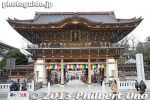
Somon Gate is what you first see, Narita-san's main gate. 総門
|
|
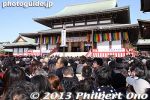
The Dai-hondo main hall of Narita-san temple. 大本堂
|
|
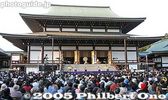
Narita-san Dai-hondo main worship hall. These people are waiting to see the taiko drum performance. 大本堂
|
|
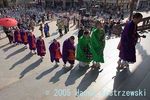
Priests at Narita-san.
|
|
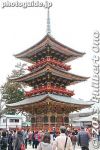
Narita-san's Three-story Pagoda, an Important Cultural Property
|
|

Tower of Peace, Narita-san Heiwa no Daito 平和の大塔
|
|

Komyodo Hall, Important Cultural Property at Narita-san. Built in 1701 and dedicated to the Dainichi Nyorai Buddha, the principal image of Shingon Buddhism. 光明堂
|
|
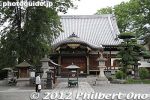
Hondo main hall at Sojiji temple in Nishi-Tokyo, Tokyo. 総持寺
|
|
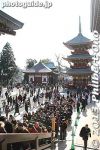
People streaming into Narita-san Shinshoji temple's main hall.
|
|

Higashi Hongwanji in Kyoto is not included in the World Heritage Site of Kyoto temples.
|
|

My favorite sight at Higashi Hongwanji in Kyoto is these giant ropes made of donated human hair. The ropes were used to reconstruct the temple during dire times.
|
|

Large way going to the graves of the 47 ronin masterless samurai at Sengakuji temple. 四十七士墓所
|
|

Sanjusangendo in Kyoto is famous for its numerous Kannon statues.
|
|

Myozenji temple bell with thatched roof
|
|

Myozenji Temple, Shirakawa-go
|
|
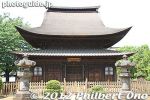
Shofukuji temple's Jizo-do Hall (地蔵堂) is one of only two buildings in Tokyo designated as a National Treasure. Near Higashi-Murayama Station on the Seibu Shinjuku Line.
|
|
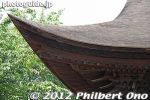
Elegant roof corner of Shofukuji temple's Jizo-do Hall (地蔵堂).
|
|

Saikyoji temple's Hondo main hall, in Otsu, Shiga. 西教寺 本堂
|
|

Main altar of Saikyoji's Hondo hall.
|
|

Saikyoji is noted for the grave of Akechi Mitsuhide, the lord of Sakamoto Castle and temple patron who helped to reconstruct the temple.
|
|

Shuzenji Temple was founded by Kobo Daishi (Kukai) in 807 was originally a Shingon Buddhist temple. Izu, Shizuoka Prefecture. 修禅寺https://shuzenji-temple.com/english.html
|
|

Zuiryuji's Sanmon Gate, a National Treasure. The original Sanmon Gate was built in 1645, but was lost in a fire in 1746. The present gate was built in 1820. 山門
|
|

Zuiryuji Butsuden Hall was built in 1659. The roof has lead plates. A magnificent example of Zen architecture. Takaoka, Toyama.
|
|

Zuiryuji temple's Hatto is the temple's main worship hall built in 1657. A National Treasure. Takaoka, Toyama. 法堂
|
|

This is the symbol of Tofukuji temple, a bridge named Tsutenkyo (通天橋) that goes across this mass of red Japanese maple trees. You see this photo in all the Kyoto travel brochures.
|
|

Ukimido pagoda, Lake Toya, Hokkaido 浮見堂
|
|

Right side of Ukimido pagoda, Lake Toya.
|
|
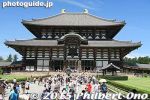
Todaiji Temple, Nara
|
|

Japan's largest Buddha statue in Todaiji. National Treasure.
|
|
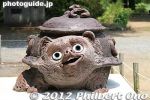
A few statues shows a tanuki morphed into a steel tea pot at Morinji temple, Tatebayashi, Gunma Prefecture. Based on the Bunbuku Chagama folktale.
|
|
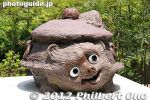
Another tanuki morphed into a steel tea pot at Morinji temple, Tatebayashi, Gunma Prefecture. Based on the Bunbuku Chagama folktale.
|
|
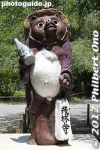
4. The large belly is for being calm as well as bold...
|
|
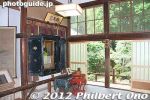
Room exhibiting the legendary chagama tea pot in Morinj temple, Tatebayashi, Gunma.
|
|
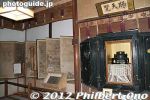
Room exhibiting the legendary chagama tea pot in Morinj temple, Tatebayashi, Gunma.
|
|

Onsenji Temple. Enter the temple here. Onsenji belongs to the Koyasan Shingon Buddhist sect. It worships an 11-face Kannon statue. Founded in 738 by the priest Dochi, Onsenji Temple is regarded as Kinosaki Onsen's guardian. 温泉寺本坊
|
|

Onsenji Temple's Hondo main hall. National Important Cultural Property. Photography is not allowed inside the temple. temple founder and priest Dochi (道智上人) is also the founder of Kinosaki Onsen hot spring.
|
|

Onsenji Temple's Tahoto pagoda.
|
|
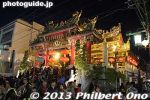
Yokohama Chinatown's main temple called Kwan Tai Temple (Kanteibyo in Japanese 関帝廟). Busy with Chinese New Year worshippers. Dedicated to Kwan Tei, a famous general in the ancient Chinese Imperial army and Taoist symbol of integrity and loyalty
|
|
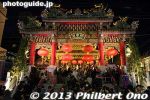
Although the temple has been around for a long time, this building was built in 1990. Very ornate. Revered by merchants. Kwan Tai Temple (Kanteibyo in Japanese 関帝廟) in Yokohama Chinatown.
|
|
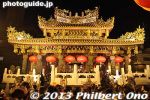
Kwan Tai Temple (Kanteibyo in Japanese 関帝廟) in Yokohama Chinatown.
|
|
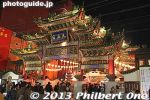
Yokohama Ma Zhu Miao Temple (Masobyo in Japanese 横浜媽祖廟), dedicated to Mazu, the goddess of the sea and travel. The goddess spirit was split from a temple in Tainan, Taiwan.
|
|
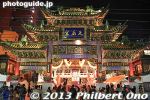
Yokohama Ma Zhu Miao Temple (Masobyo in Japanese 横浜媽祖廟) was built in 2006 to mark the 150th anniversary of Yokohama Port opening to foreign trade. Very ornate outside and inside.
|
|
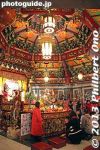
Inside Ma Zhu Miao Temple Masobyo, Yokohama. Pay a fee to enter.
|
|
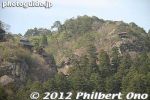
Yamadera temple, Yamagata
|
|
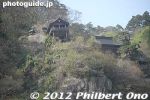
Yamadera temple, Yamagata
|
|
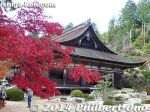
Zensuiji temple in autumn.
|
|

Gate to Zenkoji
|
|
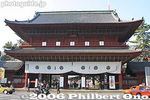
Sangedatsu-mon Gate (Sanmon) which is the temple's front gate. 三解脱門(三門)The main gate to enter the temple fronts a busy road. Important Cultural Property. "Sangedatsu" means to be released from the three earthly states of mind: greed, anger and stupidity. Walk through this gate and maybe this might happen to you.
|
|

Zojoji, Daiden (Hondo) main hall with bean-throwing stage for Setsubun on Feb. 3. 大殿Daiden (Hondo) is the temple's main worship hall. It was rebuilt in 1974. Enshrined inside is a large main image (honzon) of Amida Buddha (made during the Muromachi Period), with an image of Great Teacher Shan-tao (who perfected China's Jodo (Pure Land) Buddhism) on the right and an image of Honen Shonin (founder of Jodo-shu sect in Japan) on the left. On Feb. 3, the bean-throwing stage was set up in front.
|
|

Zojoji Head priest
|
|
|
|